Strong numbers for the Nordic labour market
The Nordic labour markets remain strong and unemployment is at its lowest level for the past three years in all of the Nordic countries. The numbers vary from 2.9 to 8.6 percent, but four of the five countries expect unemployment to fall further, according to the Nordic Economic Outlook 2017.
The Nordic countries are in different phases of the economic cycle, but common for all of them is that things are looking fairly, or very, bright. Danish unemployment figures are among the lowest for 40 years – they were lower only in 2007 and 2008, the Nordic Labour Ministers’ meeting in Oslo stated.
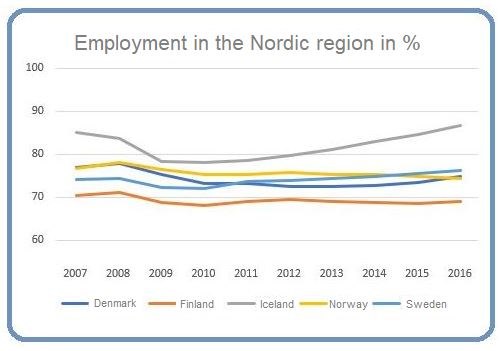
Source: Eurostat
Several of the Nordics have bounced back from the severe fall in employment figures in the wake of the 2008 economic crisis. There is a wide range – Finland’s employment rate for 2016 was 69.1 percent, compared to Iceland’s 86.6 percent. Finnish employment levels are also expected to pass 70 percent next year, before reaching 70.5 percent in 2019, according to the Nordic Economic Outlook.
Iceland has experienced the strongest growth, but has also reached the peak of its economic upturn. In 2016 growth stood at a full seven percent, while this year it is expected to be five to six percent. The tourism industry has been very strong, but there are signs that growth is slowing down there too. The labour market is under pressure and the need for labour is met with an increasing number of foreign staff. Despite the pressured economy, inflation has remained low.
Sweden has the second largest growth figures out of the Nordic countries. The country reached its peak as early as in 2015, with 4.5 percent growth. In 2016 it had dropped to 3.3 percent, while this year it is expected to end on 3.1 percent. GDP has increased by more than three percent three years in a row. That has not happened since 1998.
One of the reasons behind the strong figures is high investment levels. Not since the 1970s has more housing been built, when one million homes were constructed over a ten year period.
Swedish unemployment figures have been falling since 2014, and are at their lowest level since 2008. They have mostly fallen among young people between 14 and 24. Youth unemployment is at its lowest since 2003. In 2018 it is expected to fall to 5.9 percent.
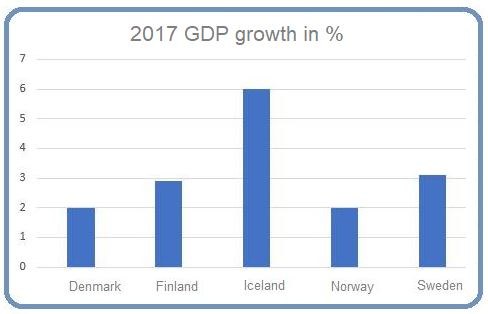
Source: Nordic Economic Outlook 2017. *The figure for Norway is the mainland economy, excluding the petroleum sector
Denmark’s GDP growth is expected to reach its highest level since 2006, growing 2 percent this year. The main drivers are exports and private consumption.
Finland has the highest unemployment rate, but is has fallen from 9.4 percent in 2015 to 8.6 percent this year, and is expected to fall to 7.8 percent in 2018.
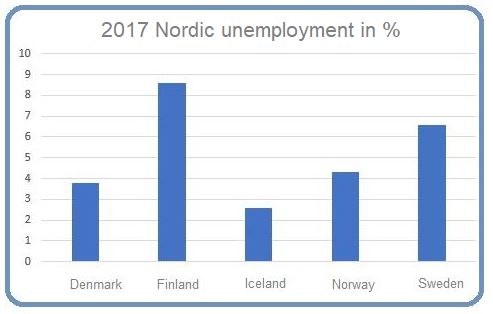
Source: Nordic Economic Outlook 2017
Finland’s economic upturn is in an earlier stage and is driven by stronger export figures for the country’s traditional products like paper, manufacturing industries and chemical products. Combined with a lot of construction activity and a relatively rapid GDP growth, this will influence employment levels. All in all this will have an impact on nearly 400,000 people.
That is ten times more than in Norway, where unemployment – despite a considerable cut to oil investments – did not grow to more than 4.7 percent in 2015. The oil price has nearly doubled compared to its lowest level in 2016. Unemployment is now falling even in the southern and western parts of Norway, home to most of the petroleum sector.
A weaker krone has led to increased exports of non-petroleum goods. GDP for the mainland economy is expected to grow by two percent this year, which is double the figure for last year.
In Denmark the upturn is broad and GDP is expected to grow faster than it has since 2006. Growth is expected to be two percent, and 1.8 percent next year. According to the Nordic Economic Outlook, 150,000 more people are in work now than in 2013, and last year alone 50,000 people found jobs. This trend is expected to continue, and the total employment level will increase with nearly three million people – close to the highest level ever.
Things have been a bit more mixed for the most vulnerable group – young people who are neither in education nor jobs.
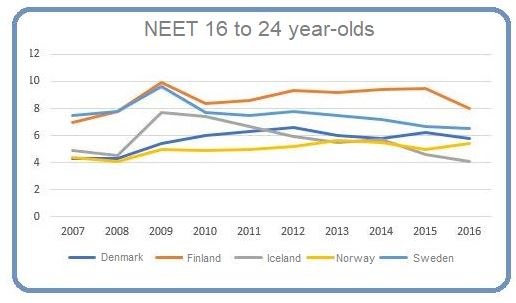
Source: Eurostat
If you look at 16 to 24 year-olds, the number has fallen compared to the tops that were reached in 2009, except from in Denmark and Norway, which had the lowest levels in the Nordic region before the economic crisis, but where the number has risen somewhat in recent years.
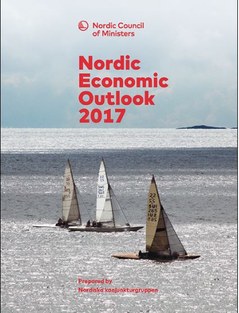
 Follow us on Facebook
Follow us on Facebook
